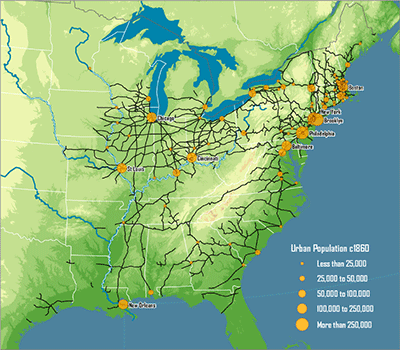Blood, Steel, and Treasure
Blood, Steel, and Treasure: The Economics of the Civil War
By Nick McGrath
The Army Historical Foundation
The Civil War was the deadliest conflict in American military history, and few communities were left untouched by it. But despite its horrors, the war enabled both sides to mobilize huge portions of their respective populations to carry on the struggle in both military service and wartime industry. As the conflict escalated into a total-war scenario, the economics of war, in both men and materiel, became the key to victory.
The Northern states had a clear superiority over the South in terms of industrial resources. It can be said that for every factory worker the Confederacy had, the Union had a factory. The only industry the South had an advantage in was cotton production, which made them valuable to countries like Great Britain who relied on Southern cotton for their textile industry. But production of iron, steel, and other military necessities were largely situated in the North (110,000 factories to the South’s 18,000). This would make wartime production as well as crucial railroad maintenance extremely difficult tasks for the mainly agrarian Confederacy. For much of the war, the Confederate military needed to supplement its supplies with captured Union stores.
Union stores.
The Union also had a comfortable advantage in manpower. The Confederate government was able to bring 90 percent of white males of military age under arms by 1864. By the end of the war, approximately 900,000 men had served in the Confederate Army, but the number serving at any given time had never exceeded 500,000. Although the Union resorted to conscription to fill the ranks of its military as the war dragged on, the vast majority of troops were still volunteers. The Union had a free population of 20 million people to the Confederacy’s free population of 6 million. By the end of the war, 2 million would have served within the ranks of the Union Army. The enslaved population proved to be an asset to both sides over the course of the war. The South would use them for domestic production to supply the Confederate military, and once liberated the North would use them as troops and as labor.
War is an expensive enterprise, which requires a state that can effectively finance it. The federal government relied on increasing taxes, borrowing, and selling bonds to finance its war effort. When this was still insufficient, the Treasury Department began printing “greenbacks” to make up the difference. This resulted in 80 percent inflation, which was minor in comparison to the Confederacy. The Confederate government had few financial institutions to begin with and had little power to raise revenue once the war started. Faced with no good choices, the Confederacy began printing money, resulting in inflation rates of up to 9,000 percent.
The only hope the South had in winning the war was for foreign recognition, which it did not receive due to the superb statesmanship of Abraham Lincoln and the lack of major strategic success by the Confederate military. The motivation and combat prowess of the average Johnny Reb mattered little when faced with the overwhelming economic disadvantages his country faced.


